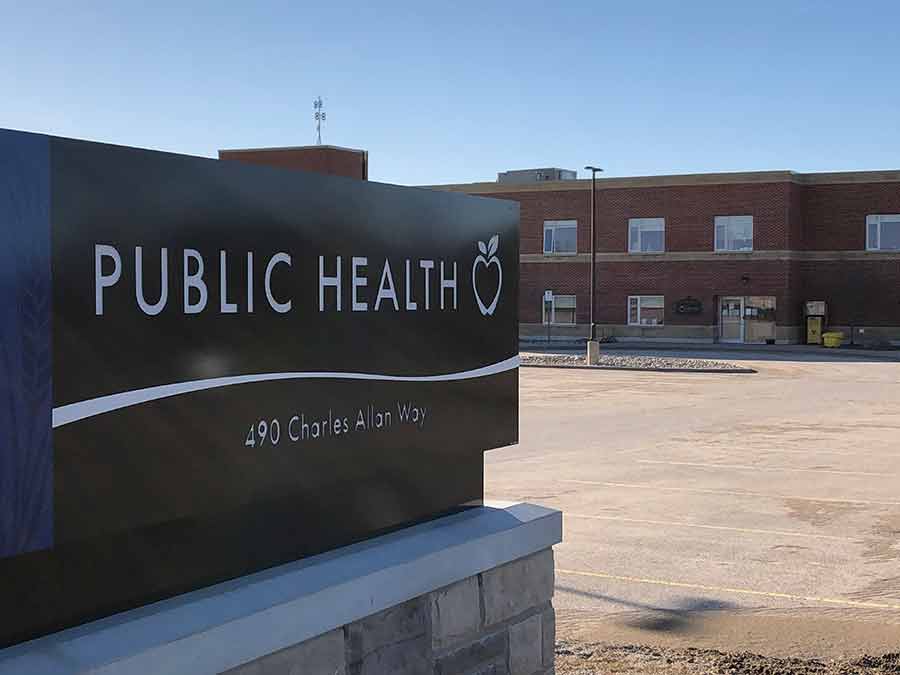GUELPH – It will take a lot for public health to declare an outbreak of COVID-19 and close a school, says Matthew Tenenbaum, associate medical officer of health for Wellington-Dufferin-Guelph Public Health (WDGPH).
“It’s fair to say it would take a lot to close a school,” he told trustees at the Sept. 1 meeting of the Upper Grand District School Board (UGDSB).
Tenenbaum outlined the school outbreak management plan devised by the local health unit, based on local data and provincial guidance.
Public health has been working with school boards as they develop their plans to reopen schools.
Part of that, and a question on many parents’ minds, is what happens if there is a case of COVID-19 at school?
In his presentation, Tenenbaum showed flow charts outlining the steps public health would take if a positive case presented at a school.
To assist with contact tracing, school boards will keep precise records of attendance, class cohorts, before/after school childcare arrangements, transportation, and visitors in the school for at least 30 days.
Whether it is a student or staff member who tests positive, public health would launch an investigation, first determining where the individual was in the past 14 days, where they spent significant amounts of time, and where the transmission was acquired.
Steps for community-acquired illness takes a different path, but if acquired at school, the team would figure out who else could have been exposed and divide that group into high- and low-risk contacts.
Low-risk contacts are people who have been near the diagnosed person but didn’t spend much time in their company, such as passing in a hallway or being nearby outdoors.
High-risk contacts would include students who sit near the diagnosed student in class or on a bus, as well as the teacher and any other staff regularly in the classroom.
High-risk individuals will be asked to isolate at home for 48 hours and if symptom-free, can return to school.
“It could be the entire class or cohort. Or it could be (contact) from outside of that cohort. We recommend they get tested,” Tenenbaum said.
The school would remain open if there were two confirmed cases as long both cases were in the same cohort, or if the second case was not connected to the first.
Two classes could be sent home, but not the entire school population.
An outbreak would be declared if there are two confirmed cases that were linked in the past 14 days and it was thought to have been acquired at school.
How that is handled depends a lot on the circumstances, too, Tenenbaum said.
What would it take to close a school?
Public health could temporarily close a school “when transmission is occurring and we can’t determine which class or cohort,” he said.
Every outbreak is different and the plan “can scale up or down as necessary,” he added.
Prevention is still at the heart of the plan, however, and Tenenbaum stressed that wearing masks, frequent hand washing, and physical distancing will reduce the risk of spread.
Tenenbaum also fielded questions from trustees and those received from the public.
If my child has seasonal allergies and therefore shows some COVID-19 symptoms, will they be sent home?
“The screening questions are asking about new and unexplained symptoms,” Tenenbaum said.
“That’s when you should be at home. But if a runny nose and eyes is not unusual in allergy season, they can go to school.”
How long do you have to stay home if you have COVID-19 symptoms?
“Public health will follow up,” he said, “but 14 days after the onset of symptoms.
“If you are tested and test negative, you can return 24 hours after you feel well again. Then the 14-day isolation is not necessary.”
Wearing masks
Tenenbaum said it is better if students wear masks until they are outside and place them in a paper or plastic bag and keep it in their pocket versus leaving masks in classrooms and then going outside.
But there is some flexibility with that if numbers are small.
He said it’s important to handle masks by the ear loops and when taking them off temporarily, to fold them so the outside is inside and then put in a bag.
Masks can be reused during the day but should be washed or replaced regularly. Replace the bag when you replace the mask, Tenenbaum said.
Masks should have two layers of breathable fabric and cover the nose, mouth and chin, he said, and be comfortable around the ears.
“Masks are effective and the more people who wear them, the more effective that intervention,” he said.
“We want to get as close to 100 per cent as we can.”
More information about returning to school, including guidance, screening and links to school board reopening plans, is available on the WDGPH website.




